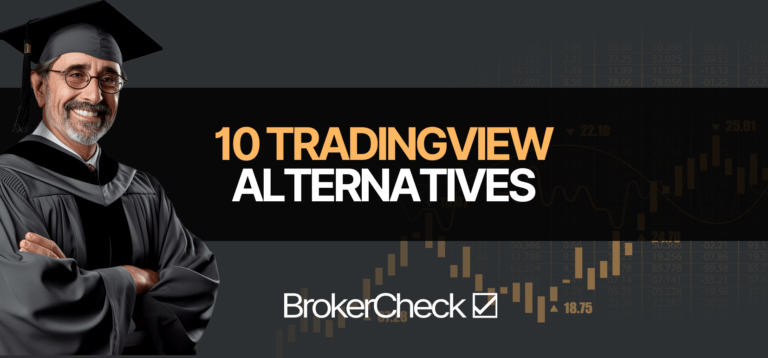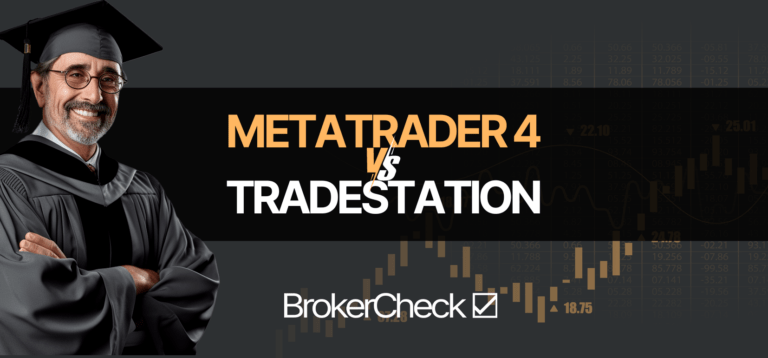1. MetaTrader 5 And TradeStation
MetaTrader 5 (MT5) is a multi-asset trading platform developed by MetaQuotes Software. It supports trading in forex, stocks, futures, options, and cryptocurrencies. It is widely used by brokers, banks, and exchanges around the world. MT5 offers advanced technical analysis tools, automated trading capabilities, and a large community of developers and users.
TradeStation is a trading platform and brokerage service provider owned by Monex Group. It specializes in trading stocks, options, futures, and cryptocurrencies. It is known for its powerful and customizable features, such as EasyLanguage, RadarScreen, and OptionStation Pro. TradeStation also provides educational resources, market data, and customer support.
Both MT5 and TradeStation are suitable for experienced and professional traders who need a robust and versatile platform. However, they also have some features and benefits that may appeal to beginners or intermediate traders. In this blog post, we will compare MT5 and TradeStation in terms of features, benefits, and costs and help you choose the right platform for your trading needs and goals.
2. Head-to-Head Comparison
2.1. Features
Trading Markets and Instruments
Both MT5 and TradeStation offer access to a wide range of trading markets and instruments. However, there are some differences in the availability and variety of instruments offered by each platform.
| Market | MT5 | TradeStation |
| Forex | Yes | Yes |
| Stocks | Yes | Yes |
| Options | No | Yes |
| Futures | Yes | Yes |
| Cryptocurrencies | Yes | Yes |
| ETFs | Yes | Yes |
| Bonds | Yes | No |
| CFDs | Yes | No |
As you can see, MT5 has more instruments than TradeStation, especially in the areas of bonds and CFDs. However, TradeStation has more options and futures contracts than MT5, as well as some unique instruments such as micro futures and binary options. Therefore, the choice of platform may depend on the type and diversity of instruments you want to trade.
User Interface and Learning Curve
Both MT5 and TradeStation have user-friendly and intuitive interfaces that allow you to easily navigate and customize the platform. However, they also have some differences in the design and layout of the interface, as well as the learning curve required to master the platform.
MT5 has a simple and minimalist interface that consists of four main windows: the market watch, the chart, the terminal, and the toolbox. You can switch between different tabs, menus, and toolbars to access various functions and features. You can also drag and drop, resize, and rearrange the windows to suit your preferences. MT5 has a relatively steep learning curve, as it has many options and settings that may overwhelm beginners. However, once you get familiar with the platform, you will find it easy to use and customize.

TradeStation has a more complex and sophisticated interface that consists of multiple windows and workspaces. You can create and save different workspaces for different trading purposes, such as analysis, execution, monitoring, and optimization. You can also access various tools and features, such as charts, indicators, scanners, strategies, and reports, from the main menu or the toolbar. TradeStation has a very steep learning curve, as it has many advanced and customizable features that require technical knowledge and skills. However, if you are willing to invest time and effort, you will find it very powerful and flexible.

Technical Analysis Tools
Both MT5 and TradeStation offer a wide range of technical analysis tools, such as indicators, drawing tools, and chart customization options. However, they also have some differences in the quality and quantity of the tools, as well as the charting styles and advanced features.
MT5 has over 80 built-in indicators and 44 analytical objects that you can use to analyze the market and identify trading opportunities. You can also download and install thousands of custom indicators and scripts from the MetaTrader Market or the Code Base. You can also create your own indicators and scripts using the MetaEditor and the MQL5 programming language. MT5 supports 21 timeframes, from one minute to one month, and three chart types: line, bar, and candlestick. You can also use advanced features such as volume profiles, market depth, and economic calendar.

TradeStation has over 200 built-in indicators and 20 drawing tools that you can use to analyze the market and identify trading opportunities. You can also download and install hundreds of custom indicators and strategies from the TradeStation TradingApp Store or the TradeStation Forum. You can also create your own indicators and strategies using the EasyLanguage Editor and the EasyLanguage programming language. TradeStation supports unlimited timeframes, from tick to monthly, and six chart types: line, bar, candlestick, Heikin-Ashi, Kagi, and Renko. You can also use advanced features such as matrix, walk-forward optimizer, and strategy performance report.

Automated Trading and Backtesting
Both MT5 and TradeStation offer automated trading and backtesting capabilities, which allow you to create, test, and execute trading strategies without manual intervention. However, they also have some differences in the functionality and performance of the automation and backtesting features, as well as the supported programming languages.
MT5 has a built-in feature called the Strategy Tester, which allows you to test and optimize your trading strategies using historical data and various testing modes. You can also use the MetaTrader Market or the Code Base to access thousands of ready-made expert advisors (EAs), which are automated trading robots that can execute trades on your behalf. You can also create your own EAs using the MetaEditor and the MQL5 programming language, which is a high-level, object-oriented language that is similar to C++.
TradeStation has a built-in feature called the Strategy Network, which allows you to test and optimize your trading strategies using historical data and various testing modes. You can also use the TradeStation TradingApp Store or the TradeStation Forum to access hundreds of ready-made strategies, which are automated trading systems that can execute trades on your behalf. You can also create your own strategies using the EasyLanguage Editor and the EasyLanguage programming language, which is a low-level, procedural language that is similar to Pascal.
Community and Support
Both MT5 and TradeStation have large and active communities of developers and users, who can provide you with support, feedback, and inspiration. However, they also have some differences in the quality and availability of the community and support resources, as well as the customer service.
MT5 has a dedicated website called the MQL5.community, which is a hub for all things related to MT5 and MQL5. You can access various resources, such as forums, blogs, articles, signals, webinars, and contests, as well as interact with other MT5 and MQL5 users and developers. You can also use the Freelance service to hire professional programmers to create custom indicators, scripts, or EAs for you. MT5 also has a comprehensive help section and a user guide that you can access from the platform. However, MT5 does not have a direct customer support service, and you may need to contact your broker or the MetaQuotes Software company for technical issues or queries.
TradeStation has a dedicated website called the TradeStation University, which is a hub for all things related to TradeStation and EasyLanguage. You can access various resources, such as tutorials, videos, webinars, events, and courses, as well as interact with other TradeStation and EasyLanguage users and developers. You can also use the TradeStation TradingApp Store or the TradeStation Forum to find or request custom indicators, strategies, or apps for your platform. TradeStation also has a comprehensive help section and a user guide that you can access from the platform. In addition, TradeStation has a direct customer support service, which you can contact via phone, email, chat, or social media for technical issues or queries.
2.2. Benefits for Different Skill Levels
Both MT5 and TradeStation are designed for experienced and professional traders who need a robust and versatile platform. However, they also have some benefits for different skill levels, such as beginners or intermediate traders. Here are some of the benefits for different skill levels:
Beginner
If you are a beginner trader, you may benefit from the following features of MT5 and TradeStation:
- MT5 has a simpler and minimalist interface that may be easier to navigate and customize.
- MT5 has more instruments and markets that may offer more trading opportunities and diversification.
- MT5 has a large and active community that may provide you with support, feedback, and inspiration.
- TradeStation has more educational resources and support that may help you learn and improve your trading skills and knowledge.
- TradeStation has more advanced and customizable features that may challenge and motivate you to grow and develop as a trader.
- TradeStation has a direct customer support service that may help you resolve technical issues or queries.
Advanced
If you are an advanced trader, you may benefit from the following features of MT5 and TradeStation:
- MT5 has a high-level and object-oriented programming language that may allow you to create more complex and sophisticated indicators and EAs.
- MT5 has a built-in feature called the Strategy Tester, which allows you to test and optimize your trading strategies using historical data and various testing modes. You can also use the MetaTrader Market or the Code Base to access thousands of ready-made expert advisors (EAs), which are automated trading robots that can execute trades on your behalf. You can also create your own EAs using the MetaEditor and the MQL5 programming language, which is a high-level, object-oriented language that is similar to C++.
- TradeStation has a built-in feature called the Strategy Network, which allows you to test and optimize your trading strategies using historical data and various testing modes. You can also use the TradeStation TradingApp Store or the TradeStation Forum to access hundreds of ready-made strategies, which are automated trading systems that can execute trades on your behalf. You can also create your own strategies using the EasyLanguage Editor and the EasyLanguage programming language, which is a low-level, procedural language that is similar to Pascal.
2.3. Cost and Fees
Both MT5 and TradeStation have different cost and fee structures, which may affect your trading profitability and budget. Here are some of the main costs and fees to consider:
Subscription Fees
Both MT5 and TradeStation do not charge subscription fees for using their platforms and services. However, TradeStation may charge a service fee based on different criteria.
| Platform | Subscription Fee | Free or Discounted Option |
| MT5 | Brokers have to pay fee to MT5. For users it is provided by Brokers for free mostly. | Free |
| TradeStation | Free | Free to use but may chare a servicing fee if you do not take 10 trades in 90 days. |
As you can see, TradeStation has higher fees than MT5, but it also offers free or discounted options for active traders. Therefore, the choice of platform may depend on your trading frequency and volume, as well as your broker or exchange.
Commissions and Spreads
Both MT5 and TradeStation charge commissions and spreads for executing trades on their platforms. These fees may vary depending on the brokers. Moreover, there are some additional commissions like SWAP or overnight position fees.
| Platform | Commission | Spread | Hidden Cost or Additional Fee |
| MT5 | Varies depending on the broker or the exchange | Varies depending on the broker or the exchange | Some brokers or exchanges may charge swap fees, overnight fees, inactivity fees, or withdrawal fees |
| TradeStation | $0.01 per share for stocks, $0.50 per contract for options, $1.50 per contract for futures, and $0.0005 per USD for forex | Varies depending on the market and the instrument | TradeStation may charge data fees, routing fees, and regulatory fees, or platform fees |
As you can see, TradeStation has lower commissions than MT5, but it also has variable spreads and other fees that may affect your trading costs. Therefore, the choice of platform may depend on your trading market and instrument, as well as your trading strategy and style.
3. Conclusion
In conclusion, MT5 and TradeStation are two of the most popular and powerful trading platforms in the industry, but they have different features and benefits for different types of traders. Here are some of the key strengths and weaknesses of each platform:
| Platform | Strength | Weakness |
| MT5 | More instruments and markets | Variable fees depending on brokers |
| MT5 | Simpler and minimalist interface | Do not provide features for advanced traders |
| MT5 | High-level and object-oriented programming language | Fewer advanced and customizable features |
| MT5 | Large and active community | No direct customer support service |
| TradeStation | Lower commissions and spreads | Fewer instruments and markets |
| TradeStation | More complex and sophisticated interface | Very steep learning curve |
| TradeStation | More advanced and customizable features | Low-level and procedural programming language |
| TradeStation | Direct customer support service | Little community support |
Therefore, the choice of platform may depend on your individual trading needs and goals. If you are looking for a platform that can handle multiple markets and instruments, has a simple and minimalist interface, and has a large and active community, you may prefer MT5. If you are looking for a platform that has lower commissions and spreads, has a more complex and sophisticated interface, and has more advanced and customizable features, you may prefer TradeStation.
However, the best way to find out which platform is right for you is to try them out for yourself. You can download a free trial or a limited demo version of each platform and explore their features and functions. You can also compare their performance and results using different trading strategies and instruments. By doing so, you will be able to make an informed and confident decision.
We hope this blog post has helped you compare MetaTrader 5 and TradeStation and choose the right platform for your trading needs and goals. If you have any questions or feedback, please feel free to contact us or leave a comment below.












